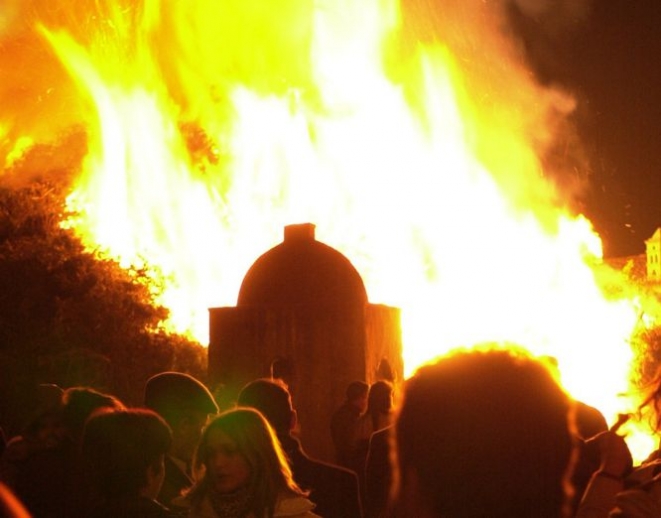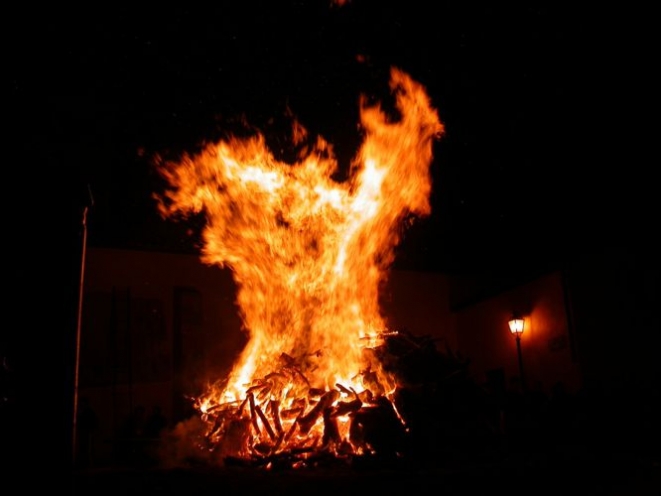The feast of Saint Anthony the Abbot
The cult of fire between sacred and profane
In the night between the 16 and 17 January, in the whole island, but especially in the inland area, or in centers strongly conservative of language and traditions, in each of these villages, during that night burns a huge bonfire in honor of Sant'Antoni de su Fogu (St. Anthony the Abbot).
In the Island the worship of this saint is very old and very sensitive. The myth that revolves around St. Anthony has its roots in the mists of time, when, by adhering to the legend, the saint descended into hell defying the demons, to steal a spark glowing, to bring it on the earth and to give it the fire to humanity.
It is easy to see how the fire in honor of Saint Anthony, (whose translation in the Sardinian language varies from place to place: su fogulone, su foghidoni, su fogu, sos focos, sas frascas su fogadoni, to mention some of these) and an event charged of meaning and it represents, not only for the legendary aspects already seen, but also about those rituals, sacred, folk and not least for the fact that performs an important function of socialization and aggregation, a very significant moment of great charm of the Sardinian tradition.
Sant'Antoni de su Fogu is the patron of agriculture and pastoralism, (core tasks in Sardinia) and it has on the shepherds and farmers a strong influence.
He is therefore one of the most venerated saints by the faithful.

The fire starting represented, in this context, a prayer time, reflection, for hoping and praying the grace of the Saint for of a good harvest.
Even today, during the holiday, although it is a bit abandoned, in its entirety, the request for the intercession of St. Anthony in purely agro-pastoral optics, letting the ritual take over the connotations of a purely aesthetic and traditional event, the bonfire lighting is the most mystical and intense moment.
The festival involves the population already a few weeks before, when several groups of children are responsible for gathering wood.
The harvested wood is piled up in the evening of Saint Anthony's day in order to form a sort of pyramid.
At twilight, the whole village gathers in the points where the piles of wood are set up and, after the blessing of the pastor, attends the ignition of the fire. In some places a long propitiatory dance around the fire accompanies the moment in which the flames rise high.
From that moment until late in the night will be a succession of balls, dances, games, songs, in which music and entertainments are not missed and where wine and delicious desserts are offered.

In addition to the fire, also the smoke seems to have a divinatory meaning rising high into the night, over the flames; it is said that looking his emission, its rise and get lost in the sky you can see omens and premonitions.
In the villages of Barbagia is this recurrence that starts the Carnival. In many villages of the inland, in fact, traditional Sardinian masks make their first appearance, (sa prima essia) the first appearance, and they entertain the community with traditional balls and rhythmic dances typical of the culture of the Barbagian carnival.
In this context, as often happens, it is impossible to separate the sacred from the profane, and here more than ever, it is clear the classic combination of Christian devotion and ancient pagan traditions.
However, it is not wrong to believe that this festival can be traced back to ancient Greece and even to refer precisely to the myth of Prometheus, mythological figure, a symbol of rebellion, that, for the Greeks, gave the gift of fire to all humanity.
It seems clear, on the basis of this, the Christianization of a cult much more archaic.
There are many aspects related to this pagan ritual which materializes the death and rebirth of a God, of the nature, the seasons, when the cyclical flow of life softens and increases what finds its symbol in the fire, element from a strong symbolic value, emblem a light that embodies the transition from the cold of winter to the warmth of spring, symbolically represented in the flames that heat the cold night.